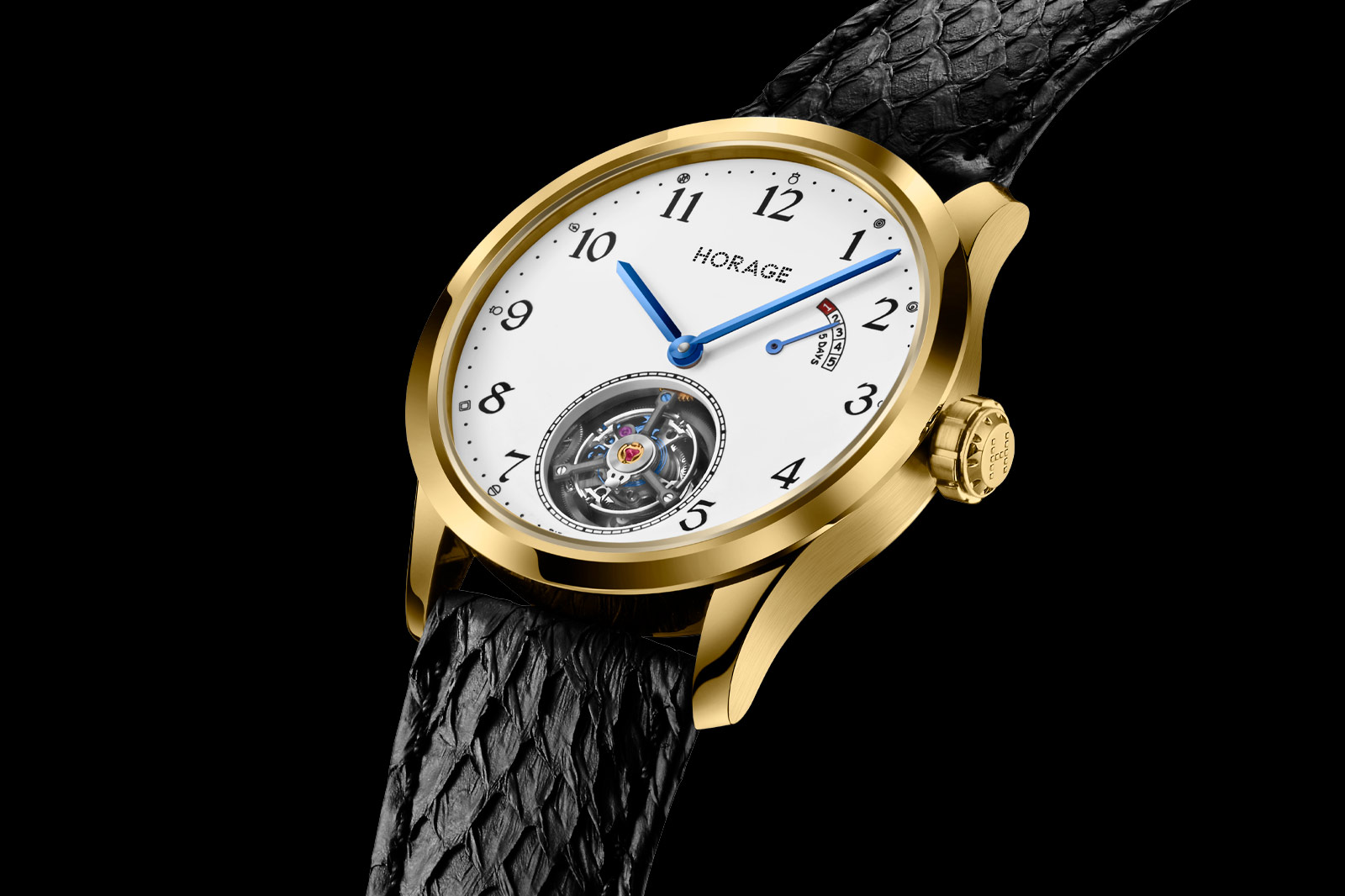
It wasn’t too long ago that a good Swiss watch was a serious investment – one presumably well worth it in terms of prestige and quality, but a good chunk of change nevertheless. That was double true of complications and, if there’s one complication that epitomised the ethos above all others, it was the tourbillon. It was the purview of the grand maisons, the heritage houses of fine watchmaking and the serious collectors that could afford them. Until, of course, independent brands with an emphasis on affordable Swiss watchmaking started making moves – brands like Horage with the Horage Tourbillon 1 and Tourbillon 2.
Horage was in an odd place when it was in the initial stirrings of producing a watch. The original aim was to use a third-party manufacturer to build its timepieces but, having exhausted its options with demands as frivolous as ‘not costing a mortgage’, it ended up going alone, a level of independence up there with the famous, auction- worthy indies that you’ll find headline at Phillips.
Horage calibre K1
Of course, Horage didn’t go in blind. Founded in 2009 by entrepreneur Andi Felsl and his wife Tzuyu Huang, they cut their calibre-building teeth at THE+, the movement-maker behind the K1 calibre that provides the foundation for Bremont’s shiny new in-house calibre. It was originally designed for Horage as practical and cost-efficient, with a silicon escapement and excellent modularity. It laid the foundations for what would become Horage’s superb range of in-house movements.
The big moment however came in 2020 with the launch of the Tourbillon 1. A skeletonised watch with a funky chequer board, mosaic-inspired non-dial, it didn’t just look the part with its 6 o’clock tourbillon, but felt it, too. Everything was on show, from the mainspring (meaning you can technically see the power reserve) to the transmission. It left nothing hidden and looked great with its proverbial clothes off. Oh, and it wasn’t just a tourbillon; it was a flying tourbillon with a peripheral gear train.
Horage Tourbillon 1, CHF 6,990
Pair that with an incredibly handsome look (especially with its bright blue bridges and silver indexes and handset), it was an instant winner. It would have been so even without a particularly impressive price tag, but throw in the fact that it cost CHF 6,990 (around £6,285) at launch absolutely put Horage on the map.
Perhaps more importantly, it highlighted what a small, independent watchmaker could do given the opportunity. This wasn’t some grand, inter-group enterprise backed by billions, but the passion project for a handful of skilled Swiss watchmakers. Strip out the huge mark-ups, marketing guff and anything that doesn’t feed directly into the watch, and this is what you get.
Horage Toubillon 2 (gold and enamel), CHF 20,470
Well, it’s been a minute since the Tourbillon 1 hit the scene and while there are certainly some good-value Swiss tourbillons out there – the Frederique Constant anniversary Manufacture Tourbillon comes to mind – there’s nothing that’s hit the nail on the head quite like Horage’s ground- breaking watch. Except, of course, for the Horage Tourbillon 2.
Frederique Constant might actually be an apt comparison here as, rather than the contemporary skeletonised take that was the Tourbillon 1, the Tourbillon 2 veers a lot more towards classical. At least, at a glance. Curvaceous, hand-drawn Arabic numerals, an open 60-second tourbillon at 6 o’clock, it all feels very familiar, right down to the grand feu enamel dial on the 41mm gold-cased, white version. In fact, there’s something downright pocket watch like about it – no bad thing.
Horage Toubillon 2 (steel and blue), CHF 8,990
The blue dialled version however takes a different approach, with a finish inspired by an ancient manuscript – Ireland’s Book of Durrow – which comes across like really fine alligator. Paired with sportier steel, it’s the more modern of the two. Either way, both dials showcase the kind of exceptional finish that, perhaps as much as the tourbillon, we’ve come to associate with the highest standards of classic Swiss watchmaking.
Horage Toubillon 2 (steel and enamel), CHF 12,980
That said, the power reserve indicator on both lessens that old-school elegance a touch, but in doing so hammers home the fact that these bad boys have a five-day power reserve. That’s via one barrel, a testament to the mechanism behind the watch, the new-and-improved K-TOU calibre, and partly due to the slightly reduced frequency compared to some other movements, down from 4Hz to 3.5Hz. And because performance may say a lot, but a picture says a thousand words, the reverse of the movement is an absolute stunner, familiar in layout and overall design to fans of the Tourbillon 1.
Now, with all those improvements and more labour- intensive dials (not to mention inflation) you can be sure that the new Tourbillon 2 will be more expensive than the 2020 original. But honestly, not by much. The blue-dialled Livre de Durrow in steel starts at CHF 8,990 (around £8,000) and the Grand Feu Enamel version, again in steel, will set you back CHF 12,980 (£11,700), with precious metal versions going up from there.
Now, that price means that the Tourbillon 2 isn’t an accessible watch per se. It’s not some impulse buy you’ll pick up at your local Ernest Jones or anything like that. But in the rarefied realms of the tourbillon, it’s borderline unthinkable. Three years later and, apparently, Horage just hasn’t had enough of showing up the Swiss watch industry – and long may it continue.
More details at Horage.
Oracle Time